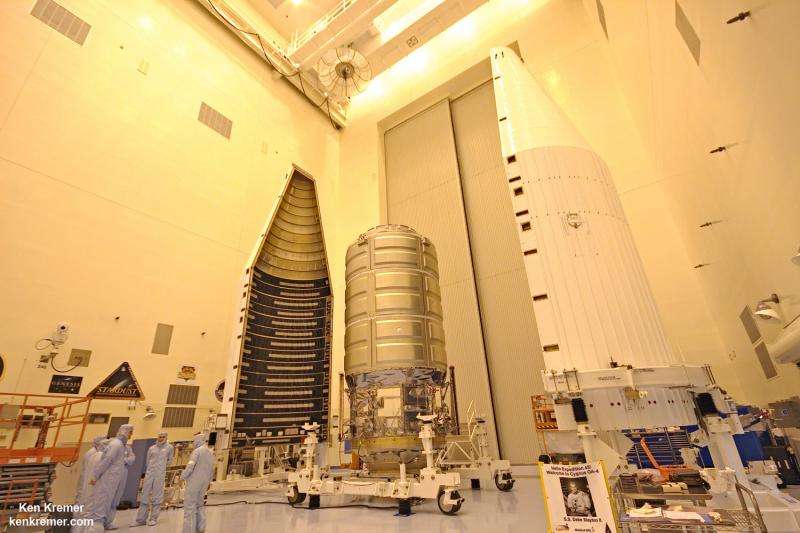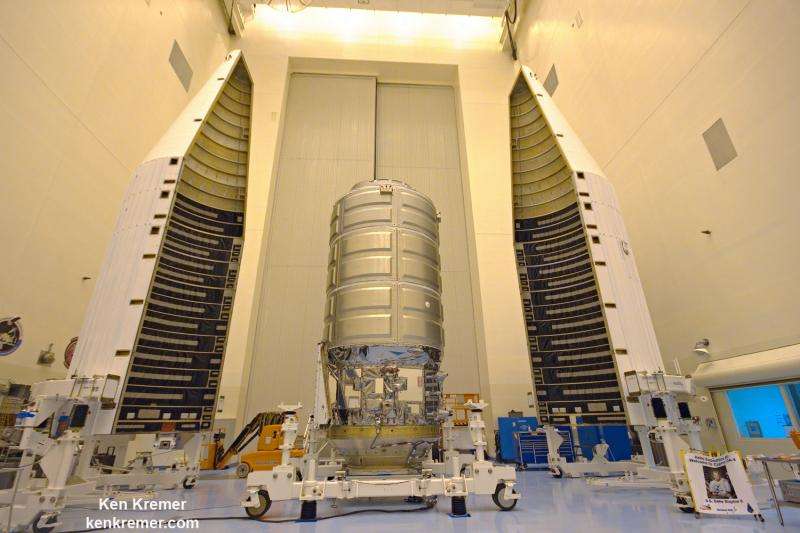First enhanced Orbital ATK Cygnus commercial cargo ship is fully assembled and being processed for blastoff to the ISS on Dec. 3, 2015 on a ULA Atlas V rocket. This view shows the Cygnus, named the SS Deke Slayton II, and twin payload enclosure fairings inside the Kennedy Space Center clean room. Credit: Ken Kremer/kenkremer.com
The largest and most advanced version of the privately developed Cygnus cargo freighter ever built by Orbital ATK is fueled, loaded and ready to go to orbit – signifying a critical turning point towards resuming American commercial cargo launches to the space station for NASA that are critical to keep it functioning.
The enhanced and fully assembled commercial Cygnus was unveiled to the media, including Universe Today, during an exclusive tour inside the clean room facility on Friday, Nov. 13, where it is undergoing final prelaunch processing at the Kennedy Space Center (KSC).
Blastoff of Cygnus atop a United Launch Alliance (ULA) Atlas V rocket on the OA-4 resupply mission under contract to NASA is anticipated on December 3, 2015 from Space Launch Complex 41 at Cape Canaveral Air Force Station in Florida at approximately 5:55 pm. ET.
The cylindrically shaped Cygnus, manufactured by Orbital ATK, was on display for the press inside the KSC clean room with both halves of the 14 foot (4 meter) wide Atlas rocket aluminum payload fairing, within which it will be encapsulated on Monday, Nov, 16, as technicians and engineers were actively at work conducting final close out operations and inspections in the Payload Hazardous Servicing Facility (PHSF).
The OA-4 mission marks the 'Return to Flight' for Cygnus and the first American based resupply mission to the International Space Station (ISS) since the twin launch failures of the last two resupply missions by both of NASA's commercial cargo providers – Orbital ATK and SpaceX in the past year.
"This is an exciting time; the Cygnus launch will resume regular U.S.-based cargo missions to the station," Randy Gordon, Launch Support Project manager for NASA, said during a media briefing.
The launch failures of the Orbital ATK Antares Orb-3 on Oct 28, 2014 and SpaceX Falcon 9 Dragon on June 28, 2015 forced a cargo resupply launch hiatus until the root causes of the mishaps are fully resolved.
It's critical that the resupply flights from Orbital ATK and rival SpaceX resume because they are the essential lifeline to the station, without which it cannot exist. The cargo missions stock the station with all manner of equipment, science experiments, food, clothing spare parts and gear for the international crews of six astronauts and cosmonauts.
"So we are trying to get some US specific items, that were critically lost on both flights, back up to the station with this flight now," Dan Tani, a former astronaut who is now Orbital ATK's vice president for Mission and Cargo Operations, told Universe Today at the media briefing.
"We got pretty close to critical on some consumables but the Japanese HTV [cargo vessel] got up there and extended that time."
"We have a team at Johnson Space Center that is tasked with tracking consumables to understand where and what the limits are."
"So its urgent to the month timeframe that we get back up to the station in December, but not to the day."
This view shows the Orbital ATK Cygnus spacecraft named the SS Deke Slayton II and twin payload enclosure fairings inside the Kennedy Space Center clean room on Nov. 13, 2015. Launch on ULA Atlas V is slated for Dec. 3, 2015. Credit: Ken Kremer/kenkremer.com
In order to get the Cygnus logistics spacecraft back into service for NASA as quickly as possible, Orbital switched rockets and the vessel will be carried to orbit for the first time by the ULA Atlas V rocket.
"The biggest impact on the crew since the Orb-3 and Dragon CRS-7 failures are some specific items like filters and cartridges. It's not what you might think of – food, water and oxygen. That can come from other partners like the Russians and Japanese," Tani explained to me.
Cygnus is named the 'SS Deke Slayton II' in memory of Deke Slayton, one of the America's original seven Mercury astronauts. He was a member of the Apollo Soyuz Test Flight. Slayton was also a champion of America's commercial space program.
The encased Cygnus spacecraft will be transported to the Cape Canaveral launch pad later this week for mating atop the Atlas V rocket, which is now being assembled for flight.
OA-4 counts as the first flight of Cygnus on an Atlas and the first launch to the ISS using an Atlas booster.
This is the first flight of the enhanced, longer Cygnus, measuring 5.1 meters (20.5 feet) tall and 3.05 meters (10 feet) in diameter, sporting a payload volume of 27 cubic meters.
"The enhanced Cygnus PCM is 1.2 meters longer, so it's about 1/3 longer," Frank DeMauro, Orbital ATK Vice President for Human Spaceflight Systems Programs, said in an exclusive interview with Universe Today.
This Cygnus is also carrying its heaviest payload to date since its significantly more voluminous than the original version.
The total payload packed on board is 3513 kilograms (7745 pounds), including science investigations, crew supplies, vehicle hardware, spacewalk equipment and computer resources.
"Since all of the experiment racks and facilities are already on board the station, we are primarily flying a lot of new samples and cartridges, to replenish those kinds of things, in addition to several new experiment packages," Tani told me.
"This Cygnus will carry more payload than all three prior vehicles combined," Tani elaborated.
The OA-4 hardware and supplies will support dozens of the approximately 250 science and research investigations being conducted by Expedition 45 and 46, including the first ever '1 Year ISS Crew' composed of NASA astronaut Scott Kelly and Russian cosmonaut Mikhail Kornienko.
Orbital ATK holds a Commercial Resupply Services (CRS) contract from NASA worth $1.9 Billion to deliver 20,000 kilograms of research experiments, crew provisions, spare parts and hardware for eight Cygnus cargo delivery flights to the ISS.
"With the increased payload capability of the enhanced Cygnus and greater lift capability of the Atlas V we can accomplish the contracted delivery in seven missions instead of the originally planned eight," Tani explained.
Orbital ATK has contracted a second Cygnus to fly on an Atlas in March 2016 on the OA-6 mission.
"Both launches on Atlas will carry over 3500 kg of cargo." Tani stated.
"We are confident on the Dec. 3 launch date. And ULA is doing really well on the launch vehicle side," DeMauro told me.
"The team has been chomping at the bit to get flying again. It's been awhile."
Source: Universe Today

























